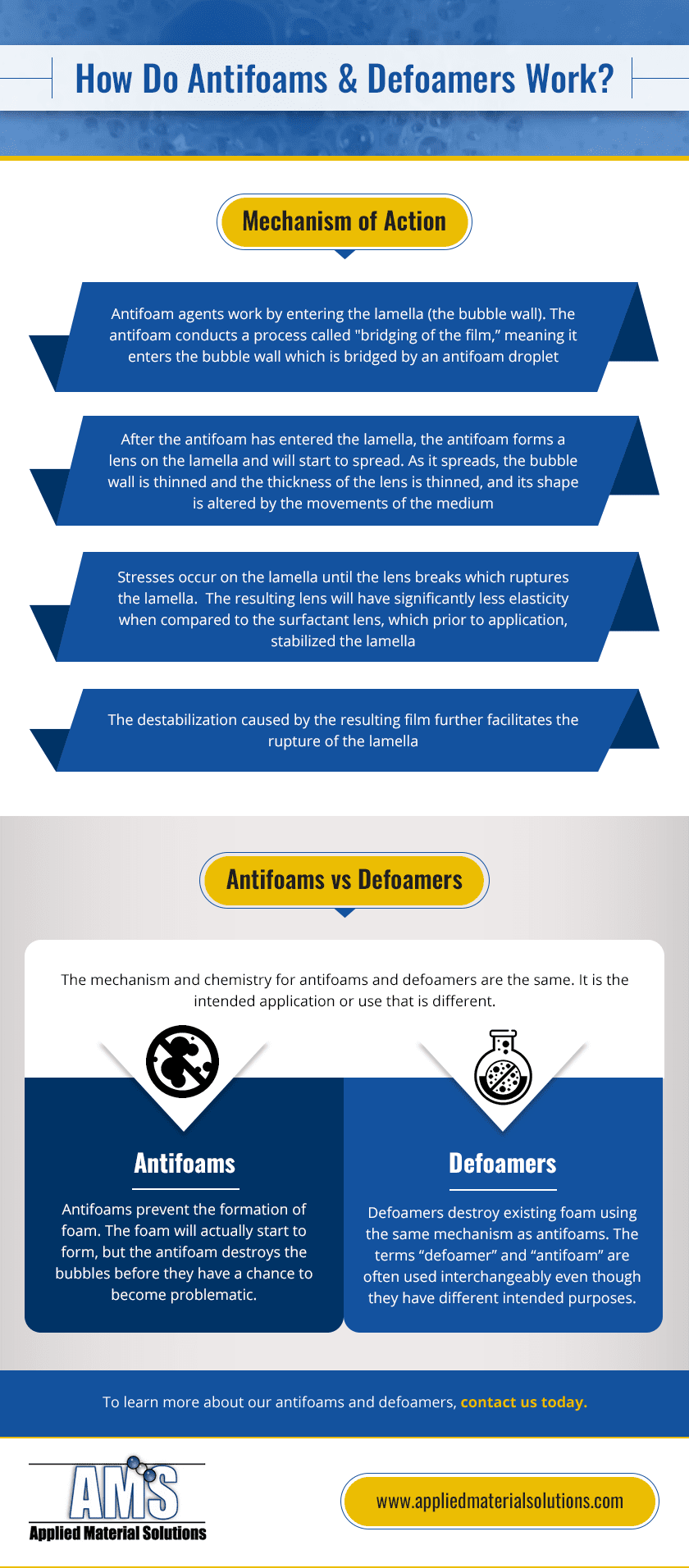Discover the Top Advantages of Utilizing Defoamers in Industrial Processes
The utilization of defoamers in commercial processes offers a range of engaging benefits that can boost operational performance and product top quality. By efficiently regulating foam production, these representatives not only enhance material flow yet likewise add to considerable price reductions and enhanced sustainability. Their application spans several fields, which increases concerns concerning their function in mitigating ecological influence while making certain consistent outcome. Understanding these advantages is critical for industries aiming to improve their procedures. The implications of embracing defoamers might be more profound than at first regarded. What specific benefits could your company harness?
Enhanced Process Effectiveness
Enhancing commercial procedures usually entails dealing with lathering problems, which can hinder operational effectiveness. Foam formation can hinder the correct performance of tools, reduce the effective use of sources, and complicate the monitoring of vital specifications. By executing defoamers, industries can successfully reduce these issues, bring about streamlined operations and improved productivity.
Defoamers job by destabilizing the foam framework, permitting fast collapse and significant reduction in foam quantity. This activity not only boosts the circulation of materials through tools, such as activators, pipelines, and mixers, but also decreases disruptions triggered by foam overflow. Equipment downtime is minimized, allowing for an extra effective and continual production procedure.
Furthermore, the usage of defoamers can cause reduced power consumption. With much less foam to manage, compressors and pumps can operate extra effectively, causing reduced operational prices and a general renovation in process throughput. Eventually, the tactical use defoamers not only addresses instant frothing challenges however also adds to an extra efficient industrial ecosystem, promoting an affordable benefit in a demanding market.
Improved Product Top Quality
The integration of defoamers in industrial procedures plays an important duty in enhancing product high quality. By properly controlling foam formation, defoamers add to the uniformity and uniformity of final items. Too much foam can result in aeration, which adversely influences the texture and stability of formulas, specifically in industries such as food and beverages, finishes, and drugs.

In addition, defoamers facilitate better blending and diffusion of components, causing homogeneity in formulas. This is necessary in applications where exact component ratios are critical for efficiency and safety and security. Furthermore, the removal of foam can reduce the threat of contamination throughout manufacturing, further protecting product honesty.
Eventually, by boosting product top quality, defoamers not only boost consumer contentment but additionally reinforce brand name reputation. Their function in keeping premium criteria highlights their relevance in modern commercial procedures.
Cost Reduction Advantages
Executing defoamers in commercial procedures can lead to considerable price decrease benefits. By successfully regulating foam formation, defoamers reduce product loss throughout production, thereby enhancing material use. This decrease in waste converts directly into lower raw product prices, improving overall operational effectiveness.
Additionally, the usage of defoamers can lower power consumption. Excessive foam can hinder devices performance, causing boosted power needs to keep manufacturing degrees. By mitigating foam, defoamers facilitate smoother operations, allowing machinery to run more efficiently and reducing energy expenditures.

In addition, defoamers can reduce processing times. Foam can create additional obstacles that lengthen manufacturing cycles. By using defoamers, markets can improve their processes, bring about faster turn-around times and enhanced throughput. This effectiveness not only increases manufacturing however likewise allows firms to fulfill market needs much more swiftly.

Environmental Effect Reduction
In industrial processes, using defoamers plays a critical function in mitigating environmental influences associated with foam generation. Foam can bring about significant operational ineffectiveness, causing increased discharges and waste generation. By successfully regulating foam, defoamers aid maintain process effectiveness, consequently lowering the total environmental footprint of operations.
Furthermore, extreme foam can overflow containment systems, causing spills that may pollute dirt and water sources. Defoamers aid decrease this threat by ensuring that foaming does not exceed prescribed limits, promoting conformity with ecological regulations. This proactive approach not just safeguards ecosystems yet additionally boosts the sustainability of commercial techniques.
Furthermore, the usage of defoamers can reduce energy consumption in various processes. defoamers. Reducing foam development lessens the requirement for extra energy-intensive steps, such as enhanced agitation or pumping, which might or else be required to handle foam. The fostering of defoamers lines up with wider sustainability goals by advertising energy efficiency while decreasing the carbon footprint of industrial tasks.
Eventually, integrating defoamers right into industrial operations is a critical procedure that supports environmental stewardship and liable resource management.
Convenience Across Industries
Throughout different industries, defoamers show impressive adaptability, adapting to the details requirements of varied applications. In the food and beverage field, for example, defoamers are essential to keeping product top quality by avoiding foam formation throughout handling, which can impact appearance and flavor. In the pharmaceutical market, defoamers ensure the stability of formulations, improving item efficacy and consistency.
In the chemical production world, defoamers help with smoother procedures by decreasing foam in reaction vessels, therefore boosting yield and minimizing downtime. The paper and pulp sector relies upon defoamers to improve the performance of pulp handling and paper production, guaranteeing optimum item integrity. Furthermore, in wastewater therapy centers, defoamers play an important function in regulating foam throughout aeration processes, resulting in enhanced therapy end results.
The versatility of defoamers reaches the oil and gas market, where they aid in taking care of foam in drilling fluids and production processes. By tailoring formulas to satisfy certain market needs, defoamers function as crucial devices that boost functional efficiency, product top quality, look here and general process performance throughout a plethora of sectors. Their adaptability underscores their worth in modern-day commercial applications.
Verdict
In final thought, the usage of defoamers in industrial procedures provides various advantages, consisting of improved efficiency, boosted item quality, significant price reductions, and positive ecological effects. Their ability to you could look here properly manage foam formation adds to operational connection and source optimization. The adaptability of defoamers across varied industries highlights their crucial duty in promoting lasting practices and earnings. The integration of defoamers stands for a strategic technique to addressing difficulties connected with foam administration in various producing environments.
Inevitably, the strategic use of defoamers not just addresses prompt foaming obstacles yet also adds to an extra efficient industrial environment, cultivating a competitive advantage in a demanding market.
In industrial processes, the use of defoamers plays a critical role in mitigating environmental effects associated with foam generation. By properly regulating foam, defoamers aid maintain procedure efficiency, thereby reducing the overall environmental footprint of operations.
Additionally, in wastewater therapy centers, defoamers play an essential duty in regulating foam throughout oygenation processes, leading to improved treatment outcomes.
